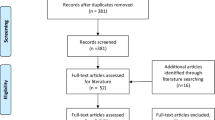Abstract
The aim of the article is to identify, describe and understand the opportunities and hindrances for young people with intellectual disabilities (ID) in forming relationships and expressing sexuality and love. The methods are participant observations at dances geared towards youths with ID and qualitative interviews with youngsters, staff members and parents. The results show a big variation of sexual conduct, where intercourse seems to be quite unusual. The study also shows that staff and parents feel responsibility for the youngsters’ sexuality and often act disciplinary as ‘new institutional walls’, while the youngsters develop different social strategies to cope with the surroundings. It seems clear that staffs need more guidance and education about sexuality and disability in their social interaction with a new generation of people with ID.
Similar content being viewed by others
REFERENCES
Löfgren-Mårtenson L: Får Jag Lov? Om Sexualitet och Kärlek i den Nya Generationen Unga Med Utvecklingsst örning. Göteborgs Universitet, Institutionen för Socialt Arbete, Göteborg, 2003.
Gullvåg Holter ∅: Raggning. Om Kärlek och Könsmarknad. Värnamo: Hammarström & åberg, 1983.
Henriksson B, Lundahl P: Ungdom, Sexualitet och Könsroller. En Intervjustudie. Göteborg: Rapport 1993:6, Institutionen för socialt arbete, Göteborgs universitet, 1993.
Longmore M: Symbolic interactionism and the study of sexuality. J Sex Res 35(1):44-57, 1998.
Weeks J: Sexuality. London and New York: Routledge, 1986.
Lewin B: Sexualiteten som en social konstruktion. UrSexologi, PO Lundberg (ed.) Falköping: Almqvist & Wiksell Medicin och Liber Utbildning, 1994.
Richters J: The Social Construction of Sexual Practice: Setting, Sexual Culture and the Body in Casual Sex between Men. Sydney: Department of Public Health and Community Medicine, University of Sydney, 2001.
Gagnon JH, Simon W: Sexual Conduct. The Social Sources of Human Sexuality. Chicago: Aldine Publisher Company, 1973.
Simon W, Gagnon JH: Sexual scripts. Permanence and change. Arch Sex Behav 15(2): 97-120, 1986.
Simon W, Gagnon JH: Sexual scripts. InCulture, Society and Sexuality. A reader, R Parker, P Aggleton (eds.) London and Philadelphia: UCLA PRESS, 1999.
Goffman E: Jaget och Maskerna. En Studie i Vardagslivets Dramatik. Kristianstad: PRISMA
Goffman E: Stigma: Den Avvikandes Roll Och Identitet. Stockholm: Rabän & Sjögren, 1973.
Angrosino MV: Metaphors of stigma. How deinstitutionalized mentally retarded adults see themselves. J Contemp Ethnography 21(2):171-199, 1992.
Holm P, Holst J, Back Olsen S, Pertl B: Efter normaliseringen. I Den Vaensklige Integreringen, J T∅ssebro (red.), Oslo: Universitetens Forlag, 1997.
Andersson B: öppna Rum-om Ungdomarnas, Staden och det Offentliga Livet. Västra Frölunda: Institutionen f ör socialt arbete, Göteborgs Universitet, 2002.
Sundet M: Jeg Vet Jeg er Annerledes-Men Ikke Bestandig. En Antropologisk Studie av Hverdagslivet till Fem Personer Med Psykisk Utviklingshemming. Uppsala: Institutionen för kulturantropologi, Uppsala. Universitet, 1997.
Mallander O: De Hjälper oss Tillrätta. Normaliseringsarbete, Självbestlämmande och Människor Med Psykisk Utvecklingsst örning. Lund: Socialhögskolan, Lunds Universitet, 1999.
McCabe M.P., Cummins R.A: The sexual knowledge, experience, feelings and need of people with mild intellectual disability. Educ Train Mental Retard Develop Disabil 3(11):13-21, 1996.
McCarthy M: Sexuality and Women with Learning Disabilities. London and Philadelphia: Jessica Kingsley Publishers, 1999.
Lewin, B. (1998) Studiens genomförande. Ur Om Sexuallivet i Sverige 1996, B. Lewin (red.) Sex i Sverige, Folkhälsoinstitutet 1998, p. 11.
Forsberg M: Ungdomar och Sexualitet-En Kunskapsöversikt 2000. Stockholm: Folkhälsoinstitutets rapport, 2000, p. 15.
Helmius G: Mogen f ör Sex?! Det Sexuellt Restriktiviserande Samhället och Ungdomars Heterosexuella Glädje. Uppsala: Sociologiska institutionen, Uppsala Universitet, 1990.
Edgerton R.B: The Cloak of Competence: Stigma in the Lives of the Mentally Retarded. Berkeley: University of California Press, 1967.
Johansson T, Hammarén N: Ungdom och Sexualitet i Gränslandet. Delrapport 1; Ung och Kåt? Om Ungdomars Sexuella Berättelser, Skövde: Institutionen för beteendevetenskap, Högskolan i Skövde, 2001.
Author information
Authors and Affiliations
Rights and permissions
About this article
Cite this article
Löfgren-Mårtenson, L. “May I?” About Sexuality and Love in the New Generation with Intellectual Disabilities. Sexuality and Disability 22, 197–207 (2004). https://doi.org/10.1023/B:SEDI.0000039062.73691.cb
Issue Date:
DOI: https://doi.org/10.1023/B:SEDI.0000039062.73691.cb




